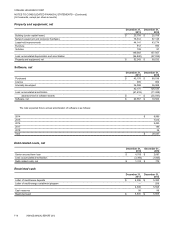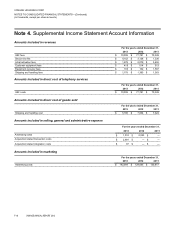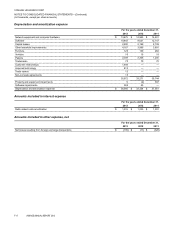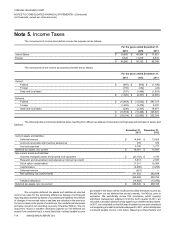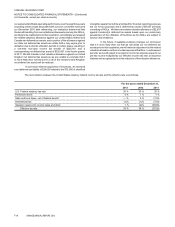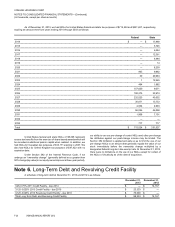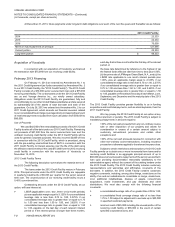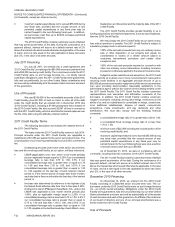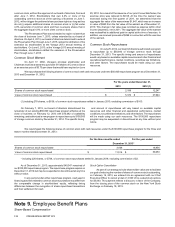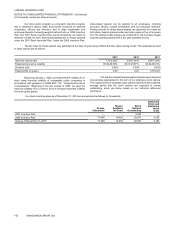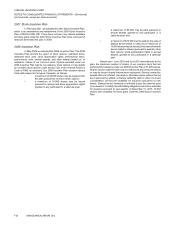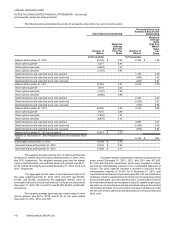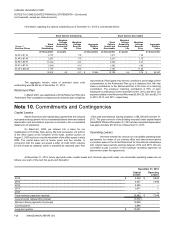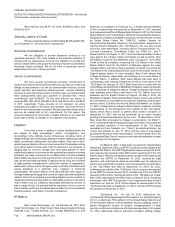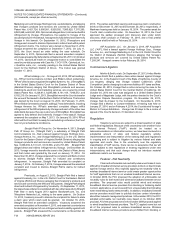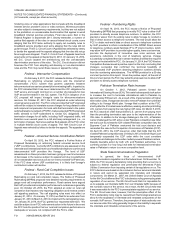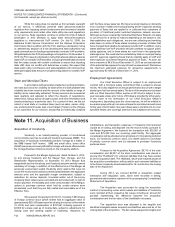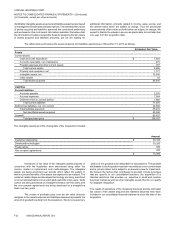Vonage 2013 Annual Report Download - page 79
Download and view the complete annual report
Please find page 79 of the 2013 Vonage annual report below. You can navigate through the pages in the report by either clicking on the pages listed below, or by using the keyword search tool below to find specific information within the annual report.
F-23 VONAGE ANNUAL REPORT 2013
We used the net proceeds of the 2010 Credit Facility of
$194,000 ($200,000 principal amount less original discount of $6,000),
plus $102,090 of cash on hand, to (i) exercise our existing right to retire
debt under our prior senior secured first lien credit facility, for 100% of
the contractual make-whole price, (ii) retire debt under our prior senior
secured second lien credit facility at a more than 25% discount to the
contractual make-whole price, and (iii) cause the conversion of all then
outstanding third lien convertible notes into 8,276 shares of our common
stock We also incurred $11,444 of fees in connection with the 2010
Credit Facility and repayment of our prior 2008 financing. We agreed to
make an additional cash payment to the holders of our prior senior
secured second lien credit facility in an aggregate amount of $9,000 if
we engaged in Qualifying Discussions (as defined in the Master
Agreement) prior to June 30, 2011 that result in a merger or acquisition
transaction (as defined in the Master Agreement) that is consummated
prior to June 30, 2012. No such discussions occurred prior to June 30,
2012.
In accordance with FASB ASC 470 “Debt Modification and
Extinguishment”, substantially all of the repayment of the Prior Financing
was treated as an extinguishment of notes resulting in a loss on early
extinguishment of notes of $26,531. For the portion of the repayment
of the Prior Financing treated as a debt modification, we carried forward
$1,072 of unamortized discount, which will be amortized to interest
expense over the life of the debt using the effective interest method in
addition to the $6,000 of original issue discount in connection with the
2010 Credit Facility. The accumulated amortization as of December 31,
2012 was $7,072, including acceleration of $6,081. The amortization
for 2011 was $915.
Repayments
In 2011, we made repayments of the entire $200,000 under
the 2010 Credit Facility, with $20,000 designated to cover our 2011
mandatory amortization, $50,000 designated to cover our 2011 annual
excess cash flow mandatory repayment, if any, and $130,000
designated to cover the outstanding principal balance under the 2010
Credit Facility at the time of the 2011 Credit Facility financing. A loss on
extinguishment of $11,806, representing a $1,000 prepayment fee to
holders of the 2010 Credit Facility, professional fees of $54, and
acceleration of unamortized debt discount and debt related costs of
$6,081 and $4,671, respectively, was recorded in 2011 as a result of
the repayments.
NOTE 7. Fair Value of Financial Instruments
Effective January 1, 2008, we adopted FASB ASC 820-10-25,
“Fair Value Measurements and Disclosures”. This standard establishes
a framework for measuring fair value and expands disclosure about fair
value measurements. We did not elect fair value accounting for any
assets and liabilities allowed by FASB ASC 825, “Financial Instruments”.
FASB ASC 820-10 defines fair value as the amount that would
be received for an asset or paid to transfer a liability (i.e., an exit price)
in the principal or most advantageous market for the asset or liability in
an orderly transaction between market participants on the measurement
date. FASB ASC 820-10 also establishes a fair value hierarchy that
requires an entity to maximize the use of observable inputs and minimize
the use of unobservable inputs when measuring fair value. FASB ASC
820-10 describes the following three levels of inputs that may be used:
> Level 1: Quoted prices (unadjusted) in active markets that are
accessible at the measurement date for identical assets and
liabilities. The fair value hierarchy gives the highest priority to
Level 1 inputs.
> Level 2: Observable prices that are based on inputs not quoted on
active markets but corroborated by market data.
> Level 3: Unobservable inputs when there is little or no market data
available, thereby requiring an entity to develop its own
assumptions. The fair value hierarchy gives the lowest priority to
Level 3 inputs.
Although management believed its valuation methods were
appropriate and consistent with other market participants, the use of
different methodologies or assumptions to determine the fair value of
certain financial instruments could have resulted in a different fair value
measurement at the reporting date.
Fair Value of Other Financial Instruments
The carrying amounts of our financial instruments, including
cash and cash equivalents, accounts receivable, and accounts payable,
approximate fair value because of their short maturities. The carrying
amounts of our capital leases approximate fair value of these obligations
based upon management’s best estimates of interest rates that would
be available for similar debt obligations at December 31, 2013 and 2012.
We believe the fair value of our debt at December 31, 2013 was
approximately the same as its carrying amount as market conditions,
including available interest rates, credit spread relative to our credit
rating, and illiquidity, remain relatively unchanged from the issuance
date of our debt on February 11, 2013 for a similar debt instrument.
Note 8. Common Stock
Net Operating Loss Rights Agreement
On June 7, 2012, we entered into a Tax Benefits Preservation
Plan ("Preservation Plan") designed to preserve stockholder value and
tax assets. Our ability to use our tax attributes to offset tax on U.S.
taxable income would be substantially limited if there were an
"ownership change" as defined under Section 382 of the U.S. Internal
Revenue Code. In general, an ownership change would occur if one or
more "5-percent shareholders," as defined under Section 382,
collectively increase their ownership in us by more than 50 percent over
a rolling three-year period.
In connection with the adoption of the Preservation Plan, our
board of directors declared a dividend of one preferred share purchase
right for each outstanding share of the Company’s common stock. The
preferred share purchase rights were distributed to stockholders of
record as of June 18, 2012, as well as to holders of the Company's
common stock issued after that date, but will only be activated if certain
triggering events under the Preservation Plan occur.
Under the Preservation Plan, preferred share purchase rights
will work to impose significant dilution upon any person or group which
acquires beneficial ownership of 4.9% or more of the outstanding
Table of Contents
VONAGE HOLDINGS CORP.
NOTES TO CONSOLIDATED FINANCIAL STATEMENTS—(Continued)
(In thousands, except per share amounts)



